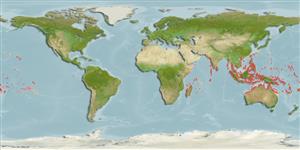Common names from other countries
Classification / Names / Names
Nomi Comuni | Sinonimi | Catalog of Fishes (gen., sp.) | ITIS | CoL | WoRMS
Environment: milieu / climate zone / depth range / distribution range
Ecologia
Associati a barriera corallina; distribuzione batimetrica 0 - 5 m (Ref. 75835). Tropical; 31°N - 28°S, 42°E - 124°W
Indo-Pacific.
Length at first maturity / Size / Peso / Age
Maturity: Lm ? range ? - ? cm Max length : 8.5 cm SHL maschio/sesso non determinato; (Ref. 821); common length : 5.0 cm SHL maschio/sesso non determinato; (Ref. 349); Età massima riportata: 3.00 anni (Ref. 117181)
One of the most frequently collected Turbinidae in the area, mainly for food. Shell also used as material for making buttons (Ref. 349). Sublittoral zone, in shallow water. Found in exposed areas of coral reefs (Ref. 349). Intertidal to 5 m, seaward on coral reefs (Ref. 75835). Herbivorous and detritus feeder (Ref. 107013).
Life cycle and mating behavior
Maturità | Riproduzione | Deposizione | Uova | Fecundity | Larve
Members of the order Patellogastropoda are mostly gonochoric and broadcast spawners. Life cycle: Embryos develop into planktonic trocophore larvae and later into juvenile veligers before becoming fully grown adults.
Poutiers, J.M. 1998. (Ref. 349)
IUCN Red List Status (Ref. 130435)
CITES status (Ref. 108899)
Not Evaluated
Not Evaluated
Threat to humans
Harmless
Human uses
Pesca: commerciale
| FishSource | Sea Around Us
Strumenti
Fonti Internet
Estimates based on models
Preferred temperature
(Ref.
115969): 25.6 - 29.3, mean 28.6 (based on 2967 cells).
Resilienza
Alto, tempo minimo di raddoppiamento della popolazione meno di 15 mesi (K=0.58; tmax=3).
Prior r = 1.19, 95% CL = 0.79 - 1.79, Based on 1 data-limited stock assessment.
Vulnerability
Low vulnerability (10 of 100).
